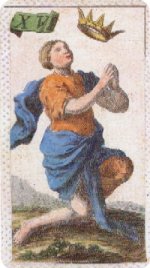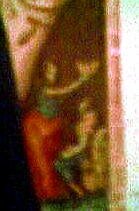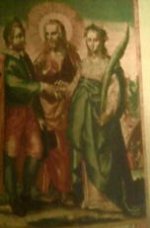Sophie-David
Somewhat to my surprise, I have found that I have connected well with the unexpected gift of an Ancient Minchiate Etruria. I recently pulled Hope (XVI) as my card of the week - please see the attachment. A man dressed in orange, and wrapped in a blue cape, holds his hands in prayer in a partially kneeling position. His orange clothing evokes warmth, energetic emotion and social engagement - and in the Chakral system orange refers to the Sacral energy of dualism. His deep blue cloak speaks of spiritual insight and royal ascent, a colour also noticeable in the Eastern Emperor, the Star, and several of the other virtues - to me this evokes the deep blue or purple of the Brow or Third Eye Chakra rather than lighter blue of the expressive Throat. In the man's prayerful position he illustrates the outpouring of his Heart.
Hope has the bare feet of a humble pilgrim, and there is a quiet strength and groundedness expressed in this simplicity and intimacy with the soil. As he travels along what seems to be a country road, it appears that he has just been struck by an inspiration, or perhaps a fear, and has paused to pray almost in mid-stride. Perhaps this is somewhat like Saint Paul's life changing encounter on the road to Damascus. A golden crown floats in the air slightly above him, reminding me of how the saints are crowned with eternal life, resting in the heart of the divine. This is his aspiration and his coming glory.
This card expresses an induction into the transformative aspect of spiritually based Hope, one of the positive aspects we might otherwise associate with the Pope or the Star. There is neither Pope nor Papess in the Minchiate, but there is The Star (unnumbered in the thirty-sixth place), and Faith (XVIII). Hope differs from Faith in that Hope is a traveller initiating in the process of conversion, whereas Faith is shown resting in divine assurance. And the white horse and kingly rider in The Star expresses a more refined theological and celestial based hope, as the Magus journeys triumphantly towards the incarnation.
I cannot ignore the standard Tarot placement of The Tower at Hope's position of XVI. Indeed I see this traveller as having recently encountered the fires of his own Tower - which does precede this Major in the Minchiate - and that the sudden overturning of egoic consciousness is the context of this man's Hope and coming transformation.
Hope has the bare feet of a humble pilgrim, and there is a quiet strength and groundedness expressed in this simplicity and intimacy with the soil. As he travels along what seems to be a country road, it appears that he has just been struck by an inspiration, or perhaps a fear, and has paused to pray almost in mid-stride. Perhaps this is somewhat like Saint Paul's life changing encounter on the road to Damascus. A golden crown floats in the air slightly above him, reminding me of how the saints are crowned with eternal life, resting in the heart of the divine. This is his aspiration and his coming glory.
This card expresses an induction into the transformative aspect of spiritually based Hope, one of the positive aspects we might otherwise associate with the Pope or the Star. There is neither Pope nor Papess in the Minchiate, but there is The Star (unnumbered in the thirty-sixth place), and Faith (XVIII). Hope differs from Faith in that Hope is a traveller initiating in the process of conversion, whereas Faith is shown resting in divine assurance. And the white horse and kingly rider in The Star expresses a more refined theological and celestial based hope, as the Magus journeys triumphantly towards the incarnation.
I cannot ignore the standard Tarot placement of The Tower at Hope's position of XVI. Indeed I see this traveller as having recently encountered the fires of his own Tower - which does precede this Major in the Minchiate - and that the sudden overturning of egoic consciousness is the context of this man's Hope and coming transformation.




